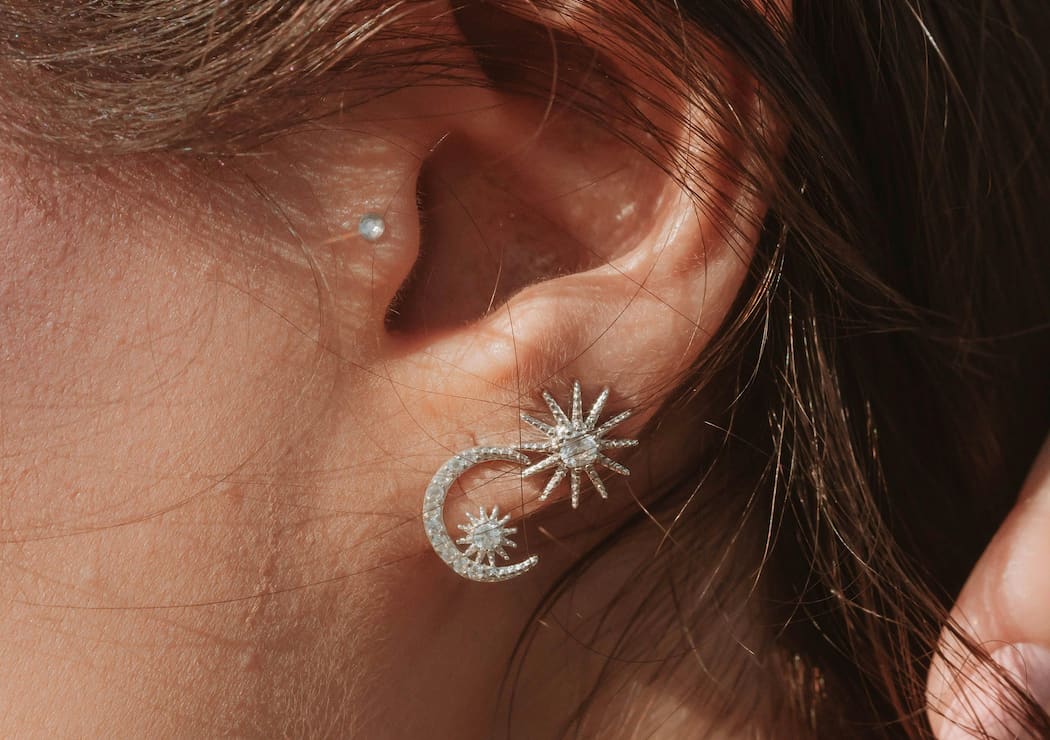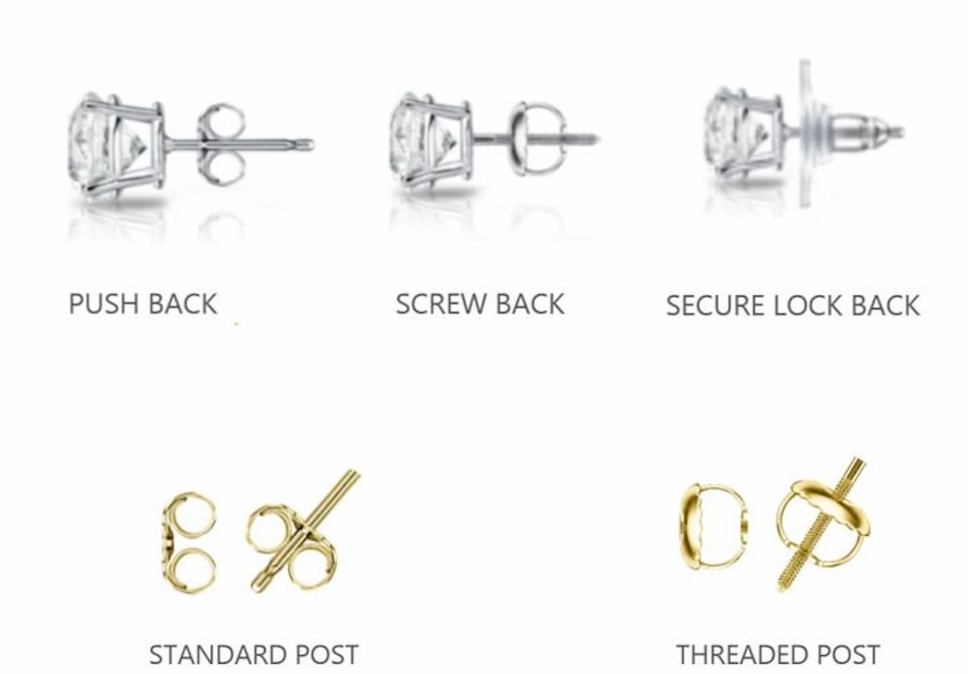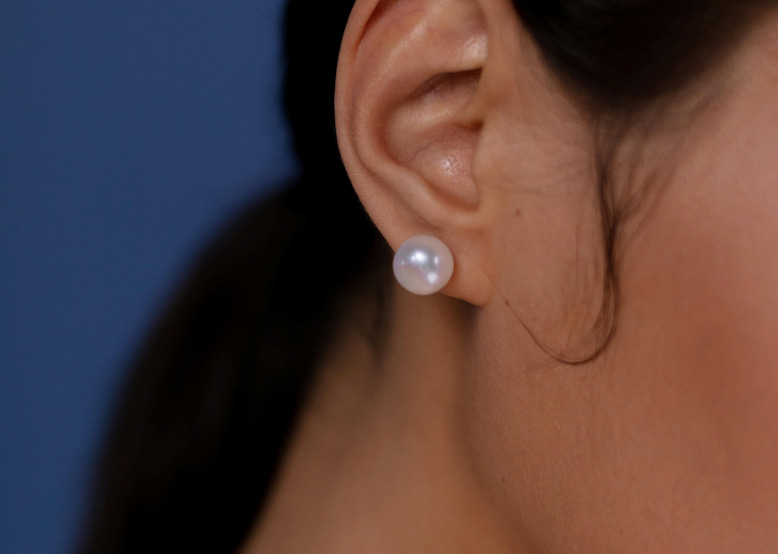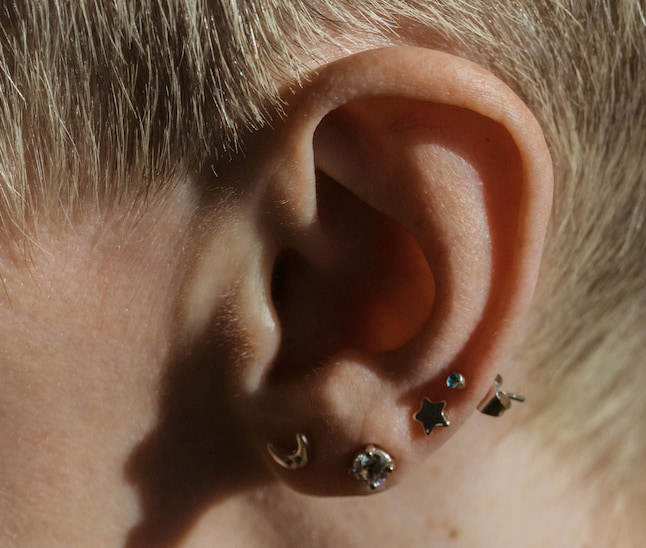Stud earrings are a classic and versatile type of jewelry that can complement any outfit, from casual to formal. Their simple yet elegant design makes them a popular choice for both men and women. But what are stud earrings exactly?
This guide explores the basics of what stud earrings are, the different types available, and how they differ from other types of earrings. Additionally, we'll provide you with tips on how to style them for any event and maintain their luster over time.

What Are Stud Earrings
So, what are earring studs exactly? Stud earrings are a type of earring characterized by their design, where a small decorative front (the stud) is mounted on a metal post that passes through the earlobe and is secured with a removable backing.
Unlike more elaborate earring styles, studs are designed to sit snugly against the ear, making them both comfortable and subtly stylish. This minimalistic design does not dangle or sway, which adds to their appeal for everyday wear.
Studs can range from simple metal balls to elaborate designs featuring precious gems like diamonds, pearls, or sapphires. Their versatility makes them suitable for all ages and occasions, from casual outings to formal events.
Different Types of Studs
Stud earrings are a versatile and elegant choice that come in a variety of designs. Here's a closer look at the main types based on their backing, pole, and front designs:
Backing Types
Push Backs (Butterfly Backs): The most common type of stud earring backing, push backs are easy to use and secure, suitable for daily wear.
Screw Backs: Offering added security, screw backs are ideal for more valuable studs like diamond earrings. They are screwed onto the post, which prevents them from falling out.
Locking Backs: Designed for maximum security, locking backs have a locking mechanism that clicks into place, ensuring the earring stays on without risk of loss.
Pole Types
Standard Posts: Suitable for Push and Locking backs, standard poles are straight and typically made from hypoallergenic metals to prevent irritation.
Threaded Posts: Offering enhanced security, threaded posts work with screw backs; the post is threaded so the back can be screwed on securely.
Front Types
Single Stone: The classic stud design featuring a single gemstone or diamond. This style focuses on showcasing the beauty of the stone itself.
Cluster: These studs feature a group of small stones grouped together to form a design. They offer a more decorative and sparkling appearance.
Themed Designs: From simple shapes like stars and hearts to intricate motifs like floral or geometric patterns, themed studs allow for personal expression and style variety.
How Stud Earrings Differ from Other Types of Earrings
Now that we know what a stud earring is and its different types, let's delve into how they differ from other types of earrings, such as hoops, dangles, and drops:
Design and Comfort: Studs are designed to sit directly on the earlobe, with minimal parts extending beyond the surface. This makes them less prone to catching on clothing or hair, unlike hoop or dangle earrings, which can swing or get entangled. Their snug fit and lightweight design offer unparalleled comfort, making them ideal for long wear and even continuous wear in piercings like second or third holes.
Visibility and Impact: Studs are more about adding a point of interest close to the face, which can enhance features subtly but effectively. In contrast, larger, more ornate earrings like hoops or drop earrings are designed to be eye-catching and serve as focal points of an outfit.
Safety and Security: Studs generally offer more security than other earring types due to their fixed position and the common use of secure backings like screw backs or locking backs. This reduces the risk of losing them compared to more mobile earring styles, which might slip out or unhook easily.
Versatility: Stud earrings offer a subtle elegance that can seamlessly transition from day to night wear. Their simplicity makes them suitable for both casual and formal occasions, unlike more elaborate earring styles such as chandeliers or statement earrings, which are typically reserved for more formal events.
How to Style Stud Earrings
Stud earrings are a staple in any jewelry wardrobe due to their versatility and elegant simplicity. Whether you're dressing for a casual day or a formal event, here are some tips on how to style stud earrings to enhance your look:
Day-to-Day Sophistication: For everyday wear, choose simple metal or gemstone studs that complement your outfit's color scheme. Silver, gold, or diamond studs can add a touch of elegance to your work attire or a casual ensemble without overpowering it.
Special Occasions: For more formal occasions, opt for studs with precious stones like diamonds, pearls, or sapphires. These can beautifully catch the light and draw attention to your face. Pair them with a matching necklace or bracelet to create a coordinated and polished look.
Face Shape Considerations: Choose stud designs that flatter your face shape. Round faces can benefit from angular studs like squares or triangles, which can add contrast, while those with square or angular faces might opt for round or oval studs to soften their features.
Layered Looks: If you have multiple ear piercings, consider layering different sizes of studs up the ear for a trendy, cohesive look. Start with the largest stud in the lowest hole and use smaller studs as you move up the ear. Mixing metals or gemstone colors can add an interesting visual contrast.
Caring for Your Stud Earrings
Proper care and maintenance of your stud earrings will ensure they remain sparkling and safe to wear for years to come. Here are essential tips on how to care for your stud earrings:
Regular Cleaning: Clean your stud earrings regularly to maintain their brilliance and prevent buildup of skin oils, cosmetics, and dirt. Use a soft, lint-free cloth for a quick daily wipe. For a deeper clean, soak your earrings in a solution of warm water and mild soap, then gently brush them with a soft toothbrush. Ensure you rinse them thoroughly to remove any soap residue.
Special Care for Gemstones: If your studs have gemstones, it's important to know their specific care requirements. For example, pearls are very delicate and should not be exposed to harsh chemicals. Similarly, some colored gemstones are sensitive to sunlight and heat. Always use cleaning methods that are safe for the type of gemstone in your studs.
Storing Properly: Store your stud earrings separately or in a lined jewelry box to prevent them from scratching or tangling with other jewelry. Consider using a stud earring organizer or individual small boxes for each pair to keep them secure and organized.
Avoiding Chemical Exposure: Remove your stud earrings before swimming, showering, or applying makeup and hairspray. Chemicals in water and cosmetics can damage both the metal and the gemstones.
Checking for Damage: Regularly inspect your studs for loose stones or bent posts. If you notice any damage, take them to a professional jeweler for repair before wearing them again. This prevents loss of gemstones and extends the life of your earrings.
Conclusion
Throughout our exploration of the question "What are stud earrings?", it's clear that stud earrings are a timeless and versatile accessory that adds elegance to any wardrobe. We've explored the various types of studs available, from classic diamonds studs to intricate themed designs, with different poles and backings. Understanding the differences between studs and other earrings can enhance your jewelry choices, allowing for better styling and care. By following the tips provided on how to style and care for your stud earrings, you can ensure that these timeless pieces continue to sparkle and elevate your style for years to come.
FAQ
Can I wear stud earrings all the time?
Yes. Stud earrings are designed to be lightweight and comfortable, making them ideal for continuous wear. However, to prevent any irritation or infection, it's important to ensure that your studs are made from hypoallergenic materials such as gold, silver, or surgical steel. Regular cleaning of both the earrings and your earlobes will also help maintain good hygiene and prolong the wearability of your studs.
Can you shower with stud earrings?
It's best to remove stud earrings before showering. Water and soap can cause buildup around the earring and on your ear, potentially leading to irritation or infection. Furthermore, if your earrings are made from materials like silver or certain types of gold, exposure to moisture can lead to tarnishing.
Can stud earrings be worn by people with sensitive ears?
Yes, stud earrings can be worn by people with sensitive ears, but it's important to choose the right materials to avoid irritation or allergic reactions. Look for studs made from hypoallergenic materials such as titanium, platinum, sterling silver, or 14k gold or higher.



